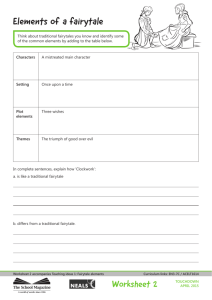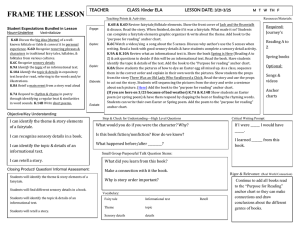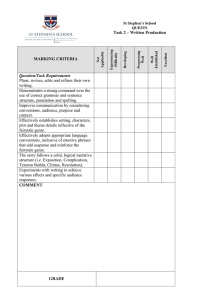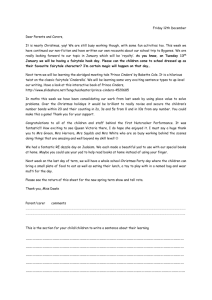Kinder LF ELAR Apr 18
advertisement
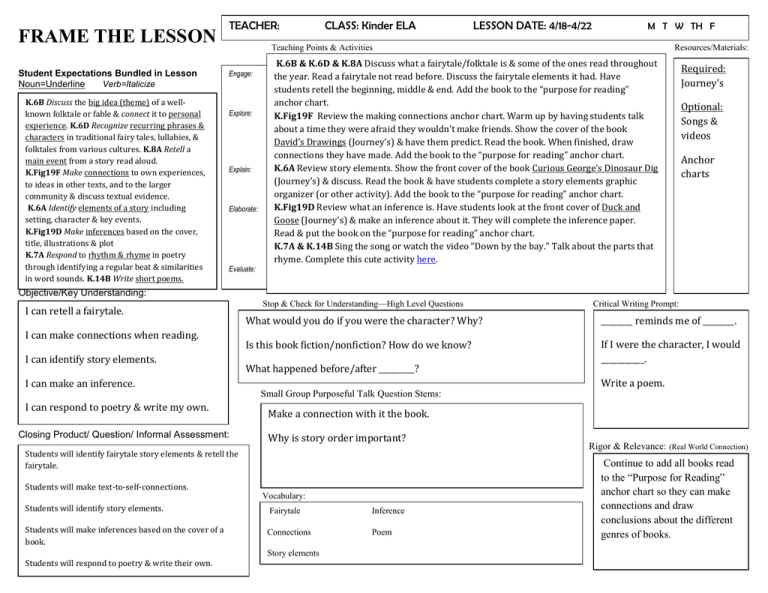
FRAME THE LESSON Student Expectations Bundled in Lesson Noun=Underline Verb=Italicize K.6B Discuss the big idea (theme) of a wellknown folktale or fable & connect it to personal experience. K.6D Recognize recurring phrases & characters in traditional fairy tales, lullabies, & folktales from various cultures. K.8A Retell a main event from a story read aloud. K.Fig19F Make connections to own experiences, to ideas in other texts, and to the larger community & discuss textual evidence. K.6A Identify elements of a story including setting, character & key events. K.Fig19D Make inferences based on the cover, title, illustrations & plot K.7A Respond to rhythm & rhyme in poetry through identifying a regular beat & similarities in word sounds. K.14B Write short poems. TEACHER: CLASS: Kinder ELA LESSON DATE: 4/18-4/22 M T W TH F Teaching Points & Activities Engage: Explore: Explain: Elaborate: Evaluate: Resources/Materials: K.6B & K.6D & K.8A Discuss what a fairytale/folktale is & some of the ones read throughout the year. Read a fairytale not read before. Discuss the fairytale elements it had. Have students retell the beginning, middle & end. Add the book to the “purpose for reading” anchor chart. K.Fig19F Review the making connections anchor chart. Warm up by having students talk about a time they were afraid they wouldn’t make friends. Show the cover of the book David’s Drawings (Journey’s) & have them predict. Read the book. When finished, draw connections they have made. Add the book to the “purpose for reading” anchor chart. K.6A Review story elements. Show the front cover of the book Curious George’s Dinosaur Dig (Journey’s) & discuss. Read the book & have students complete a story elements graphic organizer (or other activity). Add the book to the “purpose for reading” anchor chart. K.Fig19D Review what an inference is. Have students look at the front cover of Duck and Goose (Journey’s) & make an inference about it. They will complete the inference paper. Read & put the book on the “purpose for reading” anchor chart. K.7A & K.14B Sing the song or watch the video “Down by the bay.” Talk about the parts that rhyme. Complete this cute activity here. Required: Journey’s Optional: Songs & videos Anchor charts Objective/Key Understanding: I can retell a fairytale. I can make connections when reading. I can identify story elements. Stop & Check for Understanding—High Level Questions Critical Writing Prompt: What would you do if you were the character? Why? ________ reminds me of ________. Is this book fiction/nonfiction? How do we know? If I were the character, I would ___________. What happened before/after _________? Write a poem. I can make an inference. Small Group Purposeful Talk Question Stems: I can respond to poetry & write my own. Closing Product/ Question/ Informal Assessment: Make a connection with it the book. Why is story order important? Students will identify fairytale story elements & retell the fairytale. Students will make text-to-self-connections. Vocabulary: Students will identify story elements. Fairytale Inference Students will make inferences based on the cover of a book. Connections Poem Students will respond to poetry & write their own. Story elements Rigor & Relevance: (Real World Connection) Continue to add all books read to the “Purpose for Reading” anchor chart so they can make connections and draw conclusions about the different genres of books. Ongoing TEKS: K.21A Listen attentively by facing speakers & asking questions to clarify information. K.21B Follow oral directions that involve a short related sequence of actions. K.22A Share information & ideas by speaking audibly & clearly using the conventions of language. K.23A Follow agreed-upon rules for discussion, including taking turns & speaking one at a time. K.4B & K.Fig19B Ask and respond to questions about texts read aloud. K.Fig19A Discuss the purposes for reading & listening to various texts (e.g. to become involved in real & imagined events, settings actions & to enjoy language. K.Fig19C Monitor & adjust comprehension (e.g. using background knowledge, creating sensory images, rereading a portion aloud). Monday Engage Explore Explain Elaborate Evaluate Tuesday Wednesday Thursday Friday
